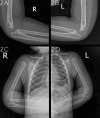Upper Extremity Pseudoparalysis: A Case Report of Bilateral Nursemaid's Elbows
- PMID: 39553088
- PMCID: PMC11569933
- DOI: 10.7759/cureus.71801
Upper Extremity Pseudoparalysis: A Case Report of Bilateral Nursemaid's Elbows
Abstract
Radial head subluxation (RHS), commonly known as 'nursemaid's elbow,' typically presents in pediatric patients with acute-onset unilateral arm pain and pseudoparalysis. The classic mechanism of injury involves a longitudinal traction force pulling the radial head through the annular ligament. Bilateral RHS is exceedingly rare, with only a few cases documented in the literature; notably, all cases with a provided history and physical exam presented with the classic mechanism of injury, aiding in diagnosis and treatment. Here, we report the case of a two-year-old male with bilateral RHS who presented to the emergency department with bilateral upper extremity pain and weakness following an unwitnessed injury. This case required a broad differential diagnosis, including musculoskeletal injury, central cord syndrome, and spinal cord injury without radiographic abnormality (SCIWORA). It underscores the importance of considering RHS in differential diagnoses, even in atypical presentations, to ensure prompt and effective management.
Keywords: atypical presentation; bilateral radial head subluxation; central cord syndrome; nursemaid's elbow; pediatric emergency medicine; pediatric musculoskeletal injury; pseudoparalysis; radial head subluxation; sciwora.
Copyright © 2024, Orta et al.
Conflict of interest statement
Human subjects: Consent was obtained or waived by all participants in this study. Conflicts of interest: In compliance with the ICMJE uniform disclosure form, all authors declare the following: Payment/services info: All authors have declared that no financial support was received from any organization for the submitted work. Financial relationships: All authors have declared that they have no financial relationships at present or within the previous three years with any organizations that might have an interest in the submitted work. Other relationships: All authors have declared that there are no other relationships or activities that could appear to have influenced the submitted work.
Figures


References
-
- Nardi NM & Schaefer TJ. (2024. StatPearls. StatPearls Publishing; [ Jun; 2024 ]. 2024. Nursemaid elbow. - PubMed
-
- Biomechanical simulation of radial head subluxation in cadaveric pediatric elbows. Meadows M, Vuong B, Storaci H, et al. J Pediatr Orthop. 2024;7:100036.
-
- Ameer MA, Tessler J, Munakomi S, Gillis CC. (2024. StatPearls. StatPearls Publishing; [ Jul; 2024 ]. 2023. Central Cord Syndrome. - PubMed
Publication types
LinkOut - more resources
Full Text Sources
